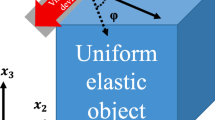Abstract
There have been developed a number of algorithms for the determination of relaxation spectrum from viscoelastic data. When viscoelastic data are given by stress relaxation test, the relation between relaxation spectrum and relaxation modulus can be transformed to that of Laplace transform. Hence, calculation of relaxation spectrum from relaxation modulus is a problem of inverting Laplace transform. Among various mathematical methods for inverse Laplace transform, the Post–Widder formula has been chosen by a number of researchers. However, they did not solve the problem by use of advance numerical technic but used low-order approximations. We suggest a new numerical algorithm which can calculate higher order solutions. In principle, the order of the Post–Widder formula is not limited in our algorithm.






Similar content being viewed by others
Data availability
The data used and/or analyzed in this study are available from the corresponding author on reasonable request.
References
Cho KS, Kwon MK, Lee J, Kim S (2017) Mathematical analysis on linear viscoelastic identification. Korea-Aust Rheol J 29:249–268
Honerkamp J (1989) Ill-posed problems in rheology. Rheol Acta 28:363–371
Lee SH, Bae J-E, Cho KS (2017) Determination of continuous relaxation spectrum based on the fuoss-kirkwood relation and logarithmic orthogonal power-series approximation. Korea Aust Rheol J 29:115–127
Tschoegl NW (1971) A general method for the determination of approximations to the spectral distributions from the dynamic response functions. Rheol Acta 10:582–594
Wiff DR (1978) RQP method of inferring a mechanical relaxation spectrum. J Rheol 22:589–597
Baumgärtel M, Winter HH (1989) Determination of discrete relaxation and retardation time spectra from dynamic mechanical data. Rheol Acta 28:511–519
Honerkamp J, Weese J (1989) Determination of the relaxation spectrum by a regularization method. Macromolecules 22:4372–4377
Honerkamp J, Elster C (1991) Modified maximum entropy method and its application to creep data. Macromolecules 24:310–314
Orbey N, Dealy J (1991) Determination of the relaxation spectrum from oscillatory shear data. J Rheol 35:1035–1049
Baumgärtel M, Winter HH (1992) Interrelation between continuous and discrete relaxation time spectra. J Non Newton Fluid Mech 44:15–36
Honerkamp J, Weese J (1993) A nonlinear regularization method for the calculation of relaxation spectra. Rheol Acta 32:65–73
Emri I, Tschoegl NW (1993) Generating line spectra from experimental reponses. Part II: storage and loss functions. Rheol Acta 32:322–327
Davies AR, Anderssen RS (1997) Sampling localization in determining the relaxation spectrum. J Non Newton Fluid Mech 73:163–179
Eckstein A, Suhm J, Fredrich C, Maier R-D, Sassmannshausen J, Bochmann M, Mülhaupt R (1998) Determination of plateau moduli and entanglement molecular weights of isotactic, syndiotactic, and atatic polypropylenes synthesized with metallocene catalyst. Macromolecules 31:1335–1340
Roths T, Maier D, Fredrich C, Marth M, Honerkamp J (2000) Determination of the relaxation time spectrum from dynamic moduli using an edge preserving regularization method. Rheol Acta 39:163–173
Stadler FJ, Bailly C (2009) A new method for the calculation of continuous relaxation spectra from dynamic-mechanical data. Rheol Acta 48:33–49
Stadler FJ, Van Ruymbeke E (2010) An improved method to obtain direct rheological evidence of monomer density requilibration for entangled polymer melts. Macromolecules 43:9205–9209
Cho KS (2010) A simple method for determination of discrete relaxation time spectrum. Macromol Res 18:363–371
Cho KS, Park GW, Soo Cho K, Woo Park G (2013) Fixed-point iteration for relaxation spectrum from dynamic mechanical data. J Rheol 57:647–648
McDougall I, Orbey N, Dearly JM (2014) Inferring meaningful relaxation spectra from experimental data. J Rheol 58:779–797
Bae J-E, Cho KS (2015) Logarithmic method for continuous relaxation spectrum and comparison with previous methods. J Rheol 59:1081–1112
Anderssen RS, Davies AR, de Hong FR, Loy RJ (2015) Derivative based algorithms for continuous relaxation spectrum recovery. J Non Newton Fluid Mech 222:132–140
Kwon MK, Cho KS (2016) Analysis of the palierne model by relaxation time spectrum. Korea-Aust Rheol J 28:23–31
Kwon MK, Lee SH, Lee SG, Cho KS (2016) Direct conversion of creep data to dynamic moduli. J Rheol 60:1181–1197
Schwarzl F, Staverman AJ (1953) Higher approximation methods for the relaxation spectrum from static and dynamic measurements of viscoelastic materials. Appl Sci Res 4:127–141
Clauser F, Knauss G (1968) On the numerical determination of relaxation and retardation spectra for linearly viscoelastic materials. Trans Soc Rheol 12:143–153
Tschoegl NW (1971) A general method for the determination of approximations to the spectral distributions from the transient reponse functions. Rheol Acta 10:595–600
Emri I, Tschoegl NW (1993) Generating line spectra from experimental reponses. Part I: relaxation modulus and creep compliance. Rheol Acta 32:311–321
Fulchiron R, Verney V, Cassagnau P, Michel A, Levoir P, Aubard J (1993) Deconvolution of polymer melt stress relaxation by the Padé–Laplace method. J Rheol 37:17–34
Cohen M (2007) Numerical methods for Laplace transform inversion. Springer, Cardiff
Ferry JD (1980) Viscoelastic properties of polymers, 3rd edn. Wiley, New York
Cho KS (2016) Viscoelasticity of polymers. Springer, Dordrecht
Lee JH, Cho KS (2022) Application of numerical differentiation to conversion of linear viscoelastic functions. Korea Aust Rheol J 34:187–796
Mansour T, Schork M (2015) Commutation relations, normal ordering, and Stirling numbers. CRC Press, New York
Acknowledgements
The authors are supported by the Mid-Career Researcher Program, through the National Research Foundation of Korea (NRF), and funded by the Ministry of Education, Science, and Technology (2019R1I1A2A02063776).
Author information
Authors and Affiliations
Corresponding author
Ethics declarations
Conflict of interest
The authors state there are no conflicts of interest.
Additional information
Publisher's Note
Springer Nature remains neutral with regard to jurisdictional claims in published maps and institutional affiliations.
Rights and permissions
Springer Nature or its licensor (e.g. a society or other partner) holds exclusive rights to this article under a publishing agreement with the author(s) or other rightsholder(s); author self-archiving of the accepted manuscript version of this article is solely governed by the terms of such publishing agreement and applicable law.
About this article
Cite this article
Cho, G., Choi, J., Lee, J. et al. Application of Post–Widder inversion formula to the calculation of relaxation spectrum from relaxation modulus. Korea-Aust. Rheol. J. 36, 79–88 (2024). https://doi.org/10.1007/s13367-023-00086-7
Received:
Revised:
Accepted:
Published:
Issue Date:
DOI: https://doi.org/10.1007/s13367-023-00086-7




